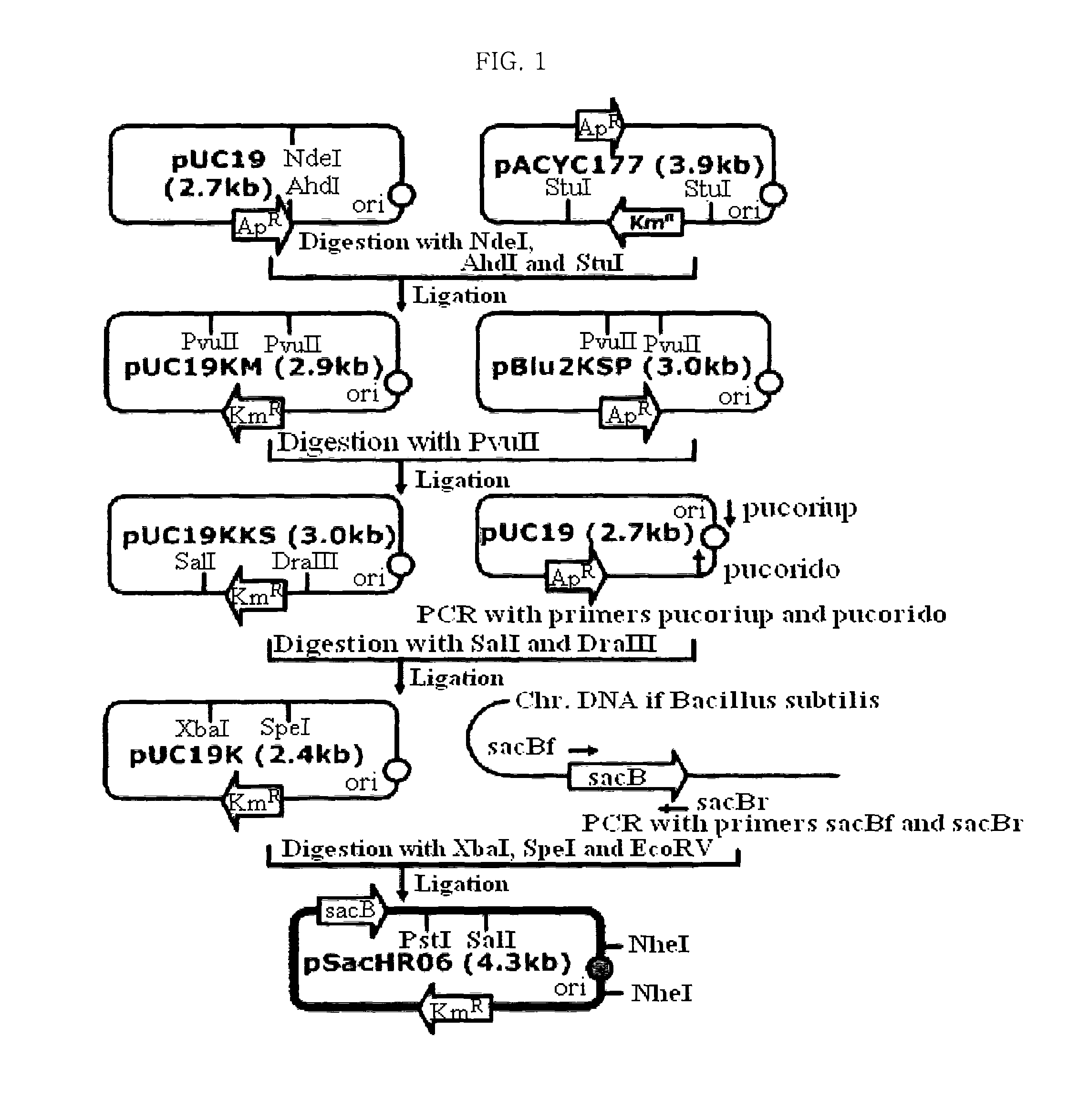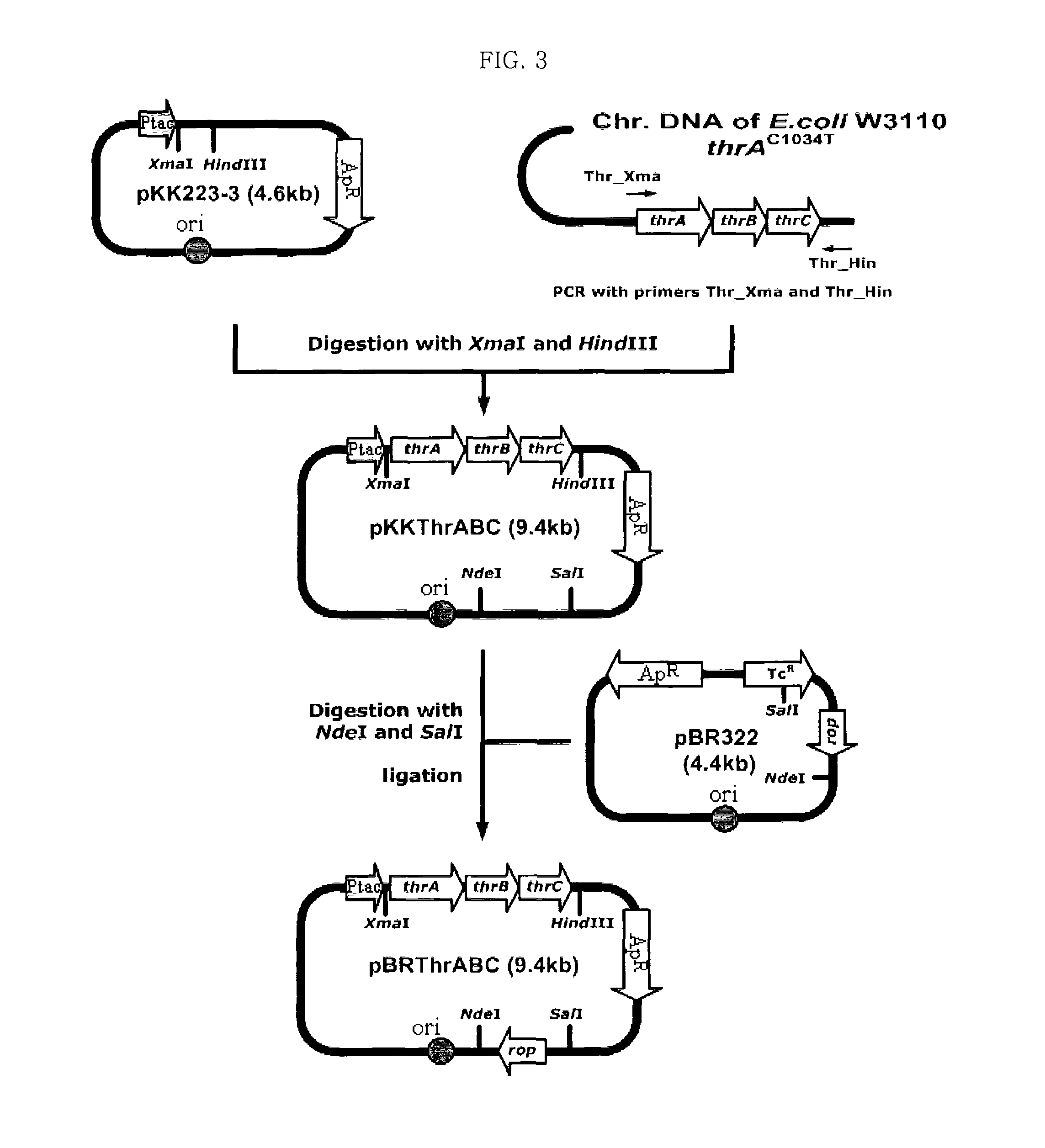L-threonine overproducing microorganism and method for preparing L-threonine using the same
a technology of l-threonine and overproduction, which is applied in the field of l-threonine overproduction microorganisms and a method for preparing l-threonine using the same, can solve the problems of above-described methods, growth rate, and sugar consumption rate decline, and achieve the effect of high yield
- Summary
- Abstract
- Description
- Claims
- Application Information
AI Technical Summary
Benefits of technology
Problems solved by technology
Method used
Image
Examples
example 1
Construction of Microorganism Having a High Ability to Produce L-Threonine
1-1: Construction of pSacHR06
[0047]In order to disrupt feedback inhibition of thrA, pSacHR06 vector was constructed for the purpose of using homologous recombination of sacB origined from Bacillus subtilus (Wohlleben et al., J. Bacteriol., 174:5462, 1992) to substitute a specific base or bases of chromosome DNA (FIG. 1).
[0048]First, to substitute ampicillin resistance gene in pUC19 vector (New England Biolab, USA) with kanamycin resistance gene, pUC19KM vector was constructed by ligating 1.5 kb fragment obtained by cutting pUC19 with NdeI and AhdI, and 1.3 kb fragment obtained by cutting pACYC177 vector (New England Biolab, USA) with Stu I.
[0049]And then, pUC19KKS vector was constructed by ligating 2.5 kb fragment obtained by cutting pUC19KM vector with PvuII, and a 400 bp fragment obtained by cutting pBluescript II KS(+) vector with PvuII. To easily remove the origin of DNA replication of pUC19KKS vector, pUC...
example 2
Preparation of L-Threonine Using L-Threonine-Producing Microorganism
[0100]In order to examine L-threonine-producing ability of THR08 constructed in Example 1, the L-threonine-producing ability of parent strain E. coli W3110 and that of THR08 microorganism were compared under the same conditions. The two strains were subcultured in LB medium added with 50 μg / ml of ampicillin to inoculate in a titration medium shown in Table 2, and then cultured at 31° C. and 250 rpm for 48 min, thus measuring the concentration of L-threonine in culture broth by HPLC.
[0101]As a result, it was confirmed that 17.8˜18.4 g / l of L-threonine, which was not produced in W3110 wild type, was produced in THR08 strain, as shown in Table 3.
[0102]
TABLE 2Composition of L-threonine titer mediumConcentrationComponents(per liter)glucose50gKH2PO44g(NH4)2SO4•7H2O14gMnSO4•5H2O10mgFeSO4•7H2O5mgMgSO4•7H2O2gL-methionine150mgL-lysine150mgyeast extract2gtrace metal solution5mlbetaine1gCaCO330g* trace metal solution (containin...
example 3
Preparation of L-Threonine Using L-Threonine-Producing Microorganisms THR27 and THE27
[0104]In order to examine L-threonine productivity of THR27 and THE27 constructed in Example 1, they were selected on LB plate containing 50 g / ml ampicillin. Each of 1% of the selected microorganisms were inoculated into four 500 ml Sakaguchi flasks having 50 ml of LB medium supplemented with 5 g / l of glucose, 0.15 g / l of L-methionine, 0.22 g / l of L-lysin and shake-cultured 250 times per minute through a horizontal movement at 31° C. for 12 hours, thus obtaining precultured broth. In order to produce L-threonine, 1.8 L of production medium having the composition shown in Table 4 was put into 5 L of small-sized fermenter, and 200 ml of the obtained prebcultured broth was inoculated in a fermenter to culture at 31° C., while automatically controlling the stirring speed to maintain 40% of oxygen partial pressure ratio, until the concentration of glucose added in the medium reached 0 g / l.
[0105]At this t...
PUM
| Property | Measurement | Unit |
|---|---|---|
| concentration | aaaaa | aaaaa |
| concentration | aaaaa | aaaaa |
| concentration | aaaaa | aaaaa |
Abstract
Description
Claims
Application Information
 Login to View More
Login to View More - R&D
- Intellectual Property
- Life Sciences
- Materials
- Tech Scout
- Unparalleled Data Quality
- Higher Quality Content
- 60% Fewer Hallucinations
Browse by: Latest US Patents, China's latest patents, Technical Efficacy Thesaurus, Application Domain, Technology Topic, Popular Technical Reports.
© 2025 PatSnap. All rights reserved.Legal|Privacy policy|Modern Slavery Act Transparency Statement|Sitemap|About US| Contact US: help@patsnap.com



